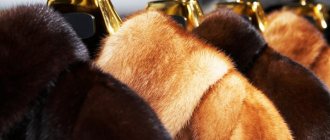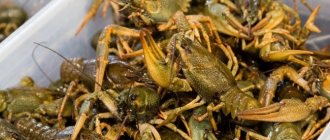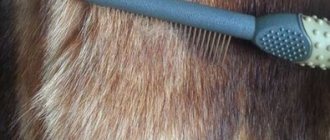- Principles of home storage of mink coats
A mink coat is without a doubt one of the “girls’ best friends.” Despite the ardent indignation of nature lovers and animal defenders, a woman looks chic in natural fur. How to properly store a mink coat so that it remains beautiful and warm for all ten seasons for which a mink is on average designed?
A mink coat is beautiful and warm. How to store it in winter and summer, read our article
For obvious reasons, storage of fur products can be divided into two states: current - during the cold period when you wear them, and long-term, when you send your furs for “preservation”. In this article we will look in detail at the subtleties and nuances of storage, but first, a little theory, from which all subsequent practical advice follows.
Content:
- Preparing mink coats for storage at home
- Prerequisites for quality storage
- Lighting and temperature
- Providing the necessary space
- Case or vacuum bag
- Organization of ventilation
- Refrigerators
- Moth protection
- Peculiarities
- Mouton
- Mink
- Other types
- Moth damage
- Creases
- Deformation of the flesh
- Yellowness or loss of color and shine
Natural products are considered reliable and durable, but you must follow all the rules, advice and recommendations of experts. High temperature, humidity, lack of ventilation, mold, the development of insect pests, and many other unpleasant scenarios have a negative impact. Therefore, in cabinets for preserving such things for the winter, it is extremely important to create a truly acceptable environment, which we will talk about in our article.
Is it possible to store a fur coat folded?
You cannot store a fur coat folded - this is an axiom. But if you didn’t know this, and when you took out your favorite item, you saw a lot of creases, then you can take some measures:
- We fill the bath with hot water.
- We take the fur coat on hangers into the bathroom and close the door tightly.
- We wait until the creases straighten out.
- We dry the item and hang it in the closet only on hangers.
The second method is suitable if there are few creases and they are not very serious:
- Wet the sponge with water.
- We iron the pile “through the wool” with it.
- Combing the fur coat.
- Dry the product.
Preparing mink coats for storage at home
Once the wearing season is over, you can't just hang up your clothes and forget about them until next fall. All necessary manipulations must be carried out correctly to ensure an optimal environment. It is convenient to conditionally divide the entire process into several main stages, so as not to get confused, do everything methodically and in order:
- Check and inspection. Carefully examine both the outside and the inside. You will have to find out not only the condition and integrity of the top material, but also the lining, the presence of all buttons or other fasteners, the quality of the seams, and their tensile strength.
- Cleansing. If there are any contaminations, they must be eliminated immediately. You can do this yourself, but it is much more productive to turn to specialists - take it to dry cleaning. When this is not possible, it is advised to mix a tablespoon of vodka and table vinegar (9%), and then wipe the surface of the stain with the solution. Dry at fairly low temperatures (14–17°C).
- Restorative procedures (if necessary). If the pile has not lost its natural shine and dust is not visible on its surface, then you can skip this phase. However, in most cases, with intensive wear it cannot be avoided. To do this, starch is sprayed onto the fur, and then gently rubbed with a completely dry sponge. After completing the procedure, it is enough to shake it out several times with vigorous movements to bring it back to its original form.
- Combing. After all the necessary procedures, you must comb it to straighten all the fibers and arrange them properly. It is recommended to use a thin metal comb for this purpose.
After preparation, hang the item in the fresh air (in the yard, on the balcony or loggia) and allow it to be tested for at least 24 hours. Then the hangers are selected exactly according to size so that all seams lie flat, do not hang down or curl, otherwise deformation cannot be avoided. The buttons are tightly fastened, and the product itself is firmly fixed.
Case or vacuum bag?
A fur coat needs a cover in any case. It is not recommended to store either a separate product without a cover, much less furs of different colors: the coloring material from one of them can be imprinted on the other.
The safety of a fur coat depends not only on temperature conditions and humidity, but also on the quality of the cover in which it is placed. When choosing it, you need to take into account a number of nuances:
- The width of the cover should not be less than the width of the product. Also pay attention to the length. It should be 10–15 cm larger than the size of the fur coat. This is necessary to ensure that the clothes do not wrinkle.
- Choose cases with side inserts. This will prevent the fur coat from being squeezed. The zipper connector should extend from the trempel to the very bottom, since this will make it more convenient to place the fur coat inside and you will avoid its deformation.
- When storing several fur coats, it is convenient to purchase covers with a transparent insert. This way you will have an idea of the location of the products without taking them out. But this insert must not be exposed to sunlight.
Ultraviolet radiation has a destructive effect on fur even through polyethylene.
Covers for storing fur must allow air to pass through and prevent exposure to ultraviolet radiation.
- For a fur coat, only a cover made of natural material is suitable: linen, cotton or canvas.. Such fabrics will help provide air access to the product.
It is not recommended to place a fur coat in a plastic bag, including a vacuum bag, as moisture (condensation) will accumulate in it, which will ruin the fur. In addition, finding a vacuum bag that fits the size of the product is problematic, and folding a fur coat, much less pressing it with a vacuum, is impossible.
- It is better to choose a case in black, brown or dark blue, since they do not transmit ultraviolet light well. But you must make sure that the paint does not transfer to the fur coat. To do this, you will need a regular damp cloth. Swipe the cover, and if you do not find any traces of paint on it, feel free to buy the product.
The cover, unfortunately, does not protect the fur from moths. Therefore, it is advisable to treat the material with a special spray or aerosol . For example, Mosquitall, Tornado or Raptor. This impregnation must be renewed every 3 months, as it loses its properties.
Important! Do not spray your fur coat, otherwise marks will remain on it; apply the product exclusively to the cover.
Don’t forget to put moth repellent in the closet or spray the cover of your fur coat
You can put pieces of cedar bark in your pockets: moths do not tolerate this aroma, and, accordingly, will not encroach on the fur coat. In addition, its smell does not disappear. Dry geranium, lavender or citrus peels are also suitable for this purpose. But folk remedies are inferior in effectiveness to aerosols and sprays. Do not use naphthalene. It repels moths well, but is a carcinogen, which is why many countries have banned its use for several years.
Prerequisites for quality storage
When figuring out how to properly store a natural mink coat at home in the summer, it is important to provide it with the necessary humidity, lighting, temperature conditions, and oxygen circulation. Experts say that a split system or air conditioner will do the job best if it is possible to install them in the right room. It is optimal to try to maintain indoor humidity within 55–65%.
The balcony or loggia of a city apartment is also not suitable for conservation, for which there are quite objective reasons. Firstly, the temperature there in summer can fluctuate significantly from hot during the day to slightly cool at night, which is best avoided if possible. Secondly, even through a special case, harmful ultraviolet radiation can affect it, changing its basic shade. It fades in spots and changes color, which is not at all good for an expensive item.
Lighting and temperature
Mink fur is extremely capricious, so improper conditions can easily lead to its damage. First of all, we are talking about the correct light mode. The room should be closed (dressing room, pantry) so that only electric lamps are present in it, the light from which is not harmful to the lint.
Storing mink coats in summer means keeping them cool, as they do not tolerate heat. Due to excessive heat, they shrink, lose their shape, lose their shine and original color, and the seams become deformed. The best option would be about 4–8°C, if possible, or at least 15–17°C.
Providing the necessary space
Expensive and beautiful clothes will require a lot of space. You can hang it in a regular closet, but you should make sure that other objects do not squeeze it on both sides - this is unacceptable. When in contact with neighboring things, the pile can rub off, become dull, and lose its attractiveness and luster.
It is very important to hang it correctly, because it cannot touch the floor or walls, that is, it hangs completely freely. It is not necessary to purchase separate furniture for this; other objects can hang at a distance without touching the mink.
Case or vacuum bag
Professionals believe that it is imperative to pack it in a special case in which it will not wrinkle. It should be quite spacious, ideally have a side, sewn-in insert that adds volume. Optimal manufacturing materials:
- cotton;
- linen;
- canvas;
- interlining;
- hemp;
- ramie (nettle).
Various synthetic materials from which some covers are made, including plastic vacuum bags, do not allow oxygen to pass through. This negatively affects the quality of the pile, as well as its further durability.
If it is expected that it will be exposed to direct sunlight, you need to choose a dark-colored case. They often also have special impregnation that protects against pests. Such options usually have a strong, specific smell. Therefore, choose a closet that closes tightly so that the aroma does not penetrate into the living space.
Organization of ventilation
Regardless of the environment, natural fur products must be regularly ventilated. Even when it is very hot outside, the flow of fresh air must be ensured on a constant basis. The mink is removed from the case and left outside (balcony, loggia) for about 22–24 hours. If you have your own yard (private sector), it is advisable to hang it under the shade of a canopy or trees, where direct sunlight does not penetrate.
Refrigerators
When figuring out how to properly store a fur coat at home, we must not forget that there are such special devices. They are a kind of cabinet in which you can adjust all the necessary indicators. It has a thermostat that sets 10–12°C, a fan for circulation, and a humidity regulator that constantly maintains 50–55%.
The cost of such a device is usually quite high, so purchasing it for one item does not make sense. In large cities you can often find companies offering services of this kind; they have special large refrigerators installed.
Moth protection
These insects can be called a real scourge for owners of expensive items made of natural fur. Pests can render it completely unusable in just a few months, completely beyond the possibility of recovery. The greatest harm can be caused by larvae that actively feed before metamorphosis. To protect against them, both folk and industrial means are used.
Anti-moth tablets can be placed in a closet, a case, or even in your pockets. It would also be a good idea to place folk remedies, such as dried herbs, in such places. It is believed that they help qualitatively:
- sagebrush;
- orange peels;
- lavender;
- geranium;
- Caucasian chamomile;
- mint;
- horse chestnut;
- fragrant tobacco;
- tansy;
- marigold.
The most common factory preparations are called aerosols, which are sprayed only on the surface of the protective case. Spraying the lining or pile is strictly prohibited, as this can cause irreparable harm - lead to a change in texture and color. However, there are special means for such manipulations. Before use, you must carefully study the instructions for use. After treatment, ventilation will most often be required for 2-3 days in the fresh air.
Rules for cold weather
Not every winter provides an opportunity to wear furs regularly: it may be too warm to wear a fur coat or too humid. However, you can’t keep a mink coat in the closet all the time in winter - it needs to be “walked.” Therefore, if it is not possible to wear a mink during the cold season, it should be hung on a closed balcony several times a season for a day or two. This technique will not only give the fur a chance to straighten out, but will also kill any moths that might have infested the fur.
What weather to wear
In what weather can you wear a fur coat? A mink coat “loves” to walk in the cold. But not every day is suitable for this event. Mink fur is very sensitive to weather. It is best to wear such a fur coat under the following conditions:
- dry, frosty air;
- low cloudiness;
- low density of people in the walking area;
- the paths are not sprinkled with chemicals to prevent icing (if the fur coat is “floor-length”).
How to dry after wet snow
How to preserve a mink coat? High air humidity harms fur. If you still cannot avoid wet snowfall or even rain, you need to take urgent measures. Upon returning home, the fur coat must be thoroughly dried. For this, you cannot use a hair dryer, radiator or other heating devices - only a natural process. Follow these six steps.
- Hang it up. The fur coat is placed on a hanger of a suitable size, with wide shoulders - this will avoid deformation of the product.
- Choose a location. The place where the fur will be dried should not be located in the sun.
- Shake. The fur coat is thoroughly shaken to remove water.
- Remove moisture. The lint is brushed off with a special mink brush, sold in fur stores.
- Get wet. If the fur coat is very wet, it is permissible to blot it with a clean soft cloth.
- Dry. Leave the product until completely dry.
The fur coat is harmed by crowding, which can wrinkle or even break the fur. Therefore, public transport, queues, and crowded crowds are not the place to “walk” expensive mink products.
Peculiarities
There are several varieties that it doesn’t hurt to take into account when organizing storage. In order for the pile to maintain an attractive and respectable appearance, it is enough to adhere to the basic rules, but it also does not hurt to provide individual care.
Mouton
Products made from this type of skin are considered the most durable, and therefore the most expensive. Like others, they should be stored in a dry and cool special cabinet, providing regular ventilation, but the temperature should be slightly lower (7–9°C). If they become damp and hang in a hot room, they will most likely soon begin to smell unpleasant, and the surface may become deformed and become dull.
It is important to know: any dirt, stains or streaks must be cleaned immediately, otherwise it will hardly be possible to remove them later. Optimally, before sending it for conservation, it wouldn’t hurt to dry-clean your mouton fur coat, even if it looks quite clean.
Mink
This is considered uncut and untreated fur, sometimes dyed. It should be stored throughout the hot period on special wide hangers, not folded or twisted. The best option would be a wardrobe made of natural wood, which maintains natural air circulation and appropriate humidity.
Other types
To prevent questions, we will give some recommendations for saving other types:
- Under no circumstances can the rabbit curl or fold, otherwise unstraightening folds and creases cannot be avoided.
- Raccoon, fox and chinchilla are very gentle and require special care. Before storing them for the summer, they are carefully hung on hangers and stored loosely, not close to each other.
- The goat is unpretentious, it can be kept in almost any conditions, but it is necessary to provide high-quality and reliable protection from pests.
- Nutria and beaver are considered the most durable, least susceptible to various damages. They should be protected from high humidity and insects, but otherwise there are no special requirements.
Preparatory stage
Before putting your fur coat in the closet, you need to prepare it. Carefully inspect for dirt, shake to remove dust. Do not comb the fur so as not to damage it. It is enough to carefully iron it with a soft brush. Hang the fur coat to air in a cool, dark place.
If there are stains, they must be removed immediately. If the product is significantly dirty, it is better to have it dry cleaned.
You need to think about where to store your fur coat in advance. It is important to take into account a number of rules:
- Do not hang the product where it may be exposed to sunlight.
- You should not leave your fur coat near heat sources (radiator, stove).
- Only cleaned fur should be sent for summer storage. A dirty mink is the best treat for moths.
- The closet must have sufficient air circulation to store items.
- Store the product on wide, comfortable hangers with buttons fastened.
READ ALSO: Fashion Girl Company - wholesale manufacturer of fashionable women's clothing
Main problems
If you keep a natural item incorrectly, you can soon lose such a beautiful and expensive item. Therefore, it makes sense to discuss the main stumbling points that most often arise among its owners.
Moth damage
Pest attack is the main headache of all happy owners of such products. The larvae completely eat away the fur at the root, and then the clothes become completely unfit for wear. There is no way to fix this, there is no way to save it, so you will have to watch it extremely carefully.
Creases
Vertical storage is the most desirable thing for a mink coat. It should hang so that cracks and then “bald spots” and holes do not form at the folds. After all, this can seriously ruin the appearance.
At first, steaming helps when there are only folds that do not want to straighten out, but then it will no longer be possible to restore the original state. Ideally, as soon as any defects appear, it is better to put it in the hands of professionals, and then avoid repeated damage in every possible way.
Deformation of the flesh
When the humidity in the room is at a very low level (less than 45%), the leather base of the skins begins to dry out. Then they become brittle or hard, unpleasant to the touch. Special treatment will help:
- For 1 liter of warm water add 1 tablespoon of vinegar and 50 grams of regular table salt. All this is thoroughly stirred until the components are completely dissolved.
- Pour the composition into a container with a sprayer, spray the inner surface and leave for 1.5-2 hours.
- Gently knead all deformed areas, and then dry in fresh air for 24 hours.
If such manipulations have no effect, you can find a specialist who will solve the problem more professionally.
Yellowness or loss of color and shine
Light mink skins sometimes become darker and turn yellow. It is recommended to wipe the pile with a swab dipped in ordinary vinegar. However, this method does not always work and it may not be possible to correct the situation.
Items made of dark fur that have changed color or become dull will hardly be able to be tidied up and given their original appearance and shine. The only effective method then becomes coloring, which you definitely can’t do at home.
Special conditions are a whim for an artificial one, but a severe necessity for a mink coat.
You can keep your fur coat in perfect condition only if certain conditions are met.
When buying an expensive coat or fur coat, you want to be irresistible and do not allow the thought that such clothing may become unusable. To prevent this from happening, it is necessary to create special storage conditions. Under the influence of various factors, such as increased air temperature, humidity or poor ventilation, natural fur can fade, turn yellow, lose wear resistance and become brittle . Hair may fall out, forming bald spots on clothing.
But this, as a rule, does not apply to artificial material. A fur coat made of synthetic fibers is not afraid of sunlight, changes in temperature and humidity, and is also not of interest to moths.
Preventing moths
To protect against insects, it is much easier to take action than to heroically deal with the consequences. They use folk remedies as soon as it is decided to put them into storage, placing herbs throughout the closet, in a case and even in pockets.
Also comes with tablets and mothballs. The latter is not in demand today due to its strong unpleasant odor. Aerosols and other industrial products should be used exclusively according to the instructions printed on the surface of the bottle or can.
Moth protection
Many manufacturers have begun to produce models of protective covers with anti-moth impregnation. But over time, it still loses its properties, so it is better to carry out additional treatment with anti-repellent agents every two months. To protect against moths, it is advisable to use products in tablets or plates, rather than sprays. Aerosol particles settle on the pile and gradually saturate it. The pile can not only become saturated with the smell of insecticide, but also deteriorate the structure due to the contact of chemicals.
Regular ventilation of the closet and treating it with anti-repellent agents will also help protect your fur coat from moths. Pay special attention to cracks, because moths can hide in the most unexpected places.
How to wear a mink coat correctly
She definitely will not tolerate neglect, so it is important not only to store it as needed, but also to use the product in accordance with the requirements.
- You should wear it on any frosty days, but in the thaw it is better to abandon this idea.
- Bright, sparkling, sunny days are not the best option to “walk” your pet. Ultraviolet light causes the pile to burn out and lose its shine.
- The item reacts sensitively to any chemicals, so it is better not to spray it with perfume, and also avoid contact with other reagents.
- If it gets wet, it is advisable to immediately straighten it on hangers and dry it at room temperature, but under no circumstances near a heating device.
- Another enemy is dust. It can not only settle on the surface, but also get clogged into the leathery base. Therefore, before the snow falls, even if it is frosty, it is better to stop wearing socks.
It is important to use it very carefully, try to avoid strong friction with other objects, otherwise the fibers will break and unsightly “bald patches” will form. Therefore, a shoulder bag is far from the best option.
Winter care for a mink coat
You should wear a mink coat often and with pleasure! The fur must breathe and be ventilated. It is clear that weather and everyday conditions for your favorite fur coat will not always be favorable. It’s not very often in our climate that frosty, dry days with little clouds occur, and you have the opportunity to walk comfortably.
Wear mink as often as possible, the fur must “breathe”
How to wear a fur coat correctly: tips
Fur has the ability to dry out, break, absorb odors, get wet, change color, etc. Therefore, pay attention to a few simple rules:
- Avoid places with a high density of people and smoky rooms.
- Stand when traveling on public transport. It is advisable not to lean against other passengers or lean on walls.
- If you use a personal car, then when getting into the cabin, carefully smooth out the fur coat underneath you and do not get carried away with heated seats. Be sure to unbutton long models to the waist, or even better, take them off and carefully place them in a free space or throw them over your shoulders. When leaving the car, straighten and fasten your fur coat well along its entire length.
- For long fur coats whose owners travel on foot, there is another harmful factor - de-icing chemicals used to treat asphalt. Raise the hem of your fur coat and, while walking through the slush, constantly hold it with your hand.
- Avoid wearing shoulder bags, wrist watches and bracelets, waist belts (especially those with large buckles), heavy jewelry, and shawls over a fur coat. Due to constant mechanical friction, the fur will wrinkle, and bald spots and bald spots will form on it.
- Do not engage in “fur piercing” by pinning brooches and other accessories to it - traces of punctures and abrasions will not go away later.
- Beware of pouring perfume and eau de toilette onto your fur coat. Substances containing alcohol cause fur to deteriorate, and the smell is absorbed for a very long time and can become unpleasant over time.
- Decorative cosmetics (lipstick, foundation, powder, blush) with constant contact with fur stain and clog it. Therefore, it is better not to allow exposed skin to come into contact with the collar of a fur coat; it is recommended to wear a headscarf or scarf underneath it.
Wear a scarf or scarf under your collar to protect your fur from decorative cosmetics.
What harms a fur coat
Natural and weather factors cause great harm to natural fur:
- sunlight. It causes fur (especially light or dyed) to fade and acquire undesirable and uneven shades;
- high temperature (above 25℃). The heat dries out the flesh, which becomes inelastic and brittle, and the pile - it quickly becomes dull, breaks and actively crumbles;
- humidity (above 60%). Fur absorbs water well, which leads to the appearance of an unpleasant odor, deformation of the interior and irreversible damage.
Natural factors harm fur; avoid rain, snow and bright sun
If your fur coat gets wet in the rain or sleet, be sure to dry it immediately upon returning home. Shake it off first to remove any remaining water; Additionally, you can blot the fur with a dry cloth. Then simply hang the fur coat on hangers (wide wooden ones), button it up and leave it in an open space indoors without direct sunlight or drafts. To speed up drying, you should absolutely not use heating devices, a hairdryer or an oven - regular room temperature is enough.
Helpful advice: You can remove minor dirt or small stains yourself. Lay the area of the fur coat that needs cleaning on a flat surface, sprinkle it with talcum powder (flour or starch), lightly rub it with your palm in the direction of the pile, remove any remaining powder with a soft cloth, shake off the fur coat and go over it with a special fur brush.
Read more about how you can clean mink fur yourself here.
Do not carry the bag on your shoulder or elbow (constant mechanical friction will cause the fur to wrinkle)
Cleaning and drying
In addition to the unkempt appearance of an expensive item, dirt on a fur coat very often means a satisfied moth. Therefore, it is better to remove dirt immediately after it appears. But if this was not possible, and then the stain was simply forgotten, then a special brush will come to the rescue.
Dry cleaning will remove complex dirt. It’s better to forget about the existence of a washing machine once and for all.
- After the fur coat has acquired its original beauty, it can be put away for storage.
- However, only perfectly dried products can be stored.
- So if in doubt, shake the fur coat thoroughly, ensuring that all hairs are completely straightened, hang it on a hanger and place it in a dry place away from heating.
If the fur has become matted during wear or storage, you will have to carefully comb your outerwear. But pulling, tearing or cutting the fibers is strictly prohibited. Unlike a cat, a fur coat will not acquire new lint.
Airing a fur coat
But even in the most spacious closet a fur coat will be boring, so in the summer you need to take care of a walk. A loggia will help with this, where the fur coat is hung about once every couple of months, protecting it from bright sunlight. In this case, the fur coat can be combed additionally.
Simple rules will help you keep your fur coat safe and save yourself from unnecessary worries about the quality of an item of clothing that is expensive in all respects.
Choosing a case
Fur should be stored in colored cases made of natural fabric.
Under no circumstances should a fur coat made from natural fur be stored without a cover. Otherwise, the product will fade, become wrinkled and lose its luxurious appearance forever. The cover must be fabric. Vacuum bags for storing fur products are contraindicated. The fact is that, firstly, the fur coat will have to be folded, since it is almost impossible to find a cover of a suitable size. And secondly, condensation forms in a closed bag, which negatively affects the villi and inner parts - treated leather, the basis for fur. So, what are the requirements for a fabric cover?
- It should be breathable and made of natural fabric (linen, cotton, canvas).
- The width of the bag should be slightly larger than the width of the fur coat.
- The length should be 10–15 cm longer than the fur product.
- The insert on the cover should be located on the side - this is the only way the fur coat will not be squeezed, and it will be much more convenient to pack it.
- It is better if the cover has a transparent “window” - when storing several fur items in one closet, it will be more convenient for you to figure out which is which.
- The sun's rays should not fall on this transparent insert, since ultraviolet radiation negatively affects fur even through polyethylene.
- The color of the cover should repel sunlight, so rich blue, dark brown, and black are preferred (to prevent the paint from transferring to the fur coat, when purchasing a packaging bag, run a damp cloth along the inside - if there are no marks left, you can buy).
- Before placing the fur coat in the cover, treat it with anti-moth spray, and then repeat the treatment every 3 months.
Storing fur products in the refrigerator
If you want to save yourself the headache and responsibility for preserving capricious fur in the summer, put the item in the refrigerator.
- The service of storing fur items in the refrigerator is provided by dry cleaning.
- Caring for your fur coat in conditions with optimal temperature and humidity levels will keep the item in good condition.
- If you wish, you can use the services of an insurance company.











